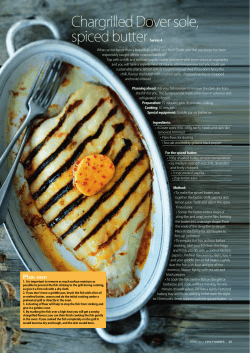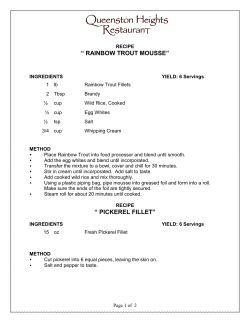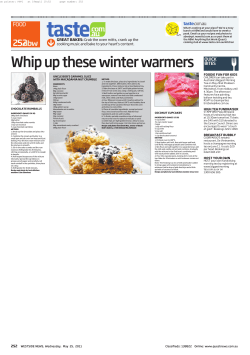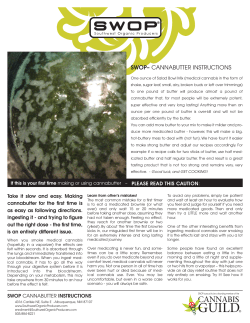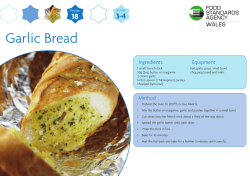
Three Seasons Ayurveda Ghee
Three Seasons Ayurveda Ghee Ghee (clarified butter) is an oil with a long and fascinating history. It has been a staple in Indian cooking for centuries and was first documented in the 17th century Ayurvedic text Bhvaprakasa. Ghee also transcends the cooking realm as ghee is also often used in religious ceremonies and various healing arts in Indian culture. Ghee contains a balance of easy to digest essential fatty acids that are essential for healthy skin, nerves and cells. The wondrous benefits of ghee fats may seem contradictory based on what we have heard about butter but we know that poor quality fats (i.e. non-organic, heat treated, solvent extracted, trans fat and hydrogenated) cause the production of free radicals that damage cells due to oxidation, this means that poor quality fats can endanger our health. “Ghee is sweet in taste and cooling in energy, rejuvenation, good for the eyes and vision, enkindles digestion, bestows luster & beauty, enhances memory-stamina, increases the intellect, promotes longevity, is an aphrodisiac and protects the body from disease” Bhvaprakasa 17th Century Ayurvedic Text Purity Farms Available at Whole Foods Market Ghee is in fact clarified butter; the process of clarifying butter is called rendering. When the butter is melted the ghee separates from the water (which is froth on the top) and the milk solids (which is what collects on the bottom) and the remaining oil is the Ghee. Fats are essential to life and vitamins A, D, E and K are only made available to the body when taken with fats. Fats also provide essential fatty acids (EFAs). They are essential because the body cannot make them and we need them to live. EFAs (Omega 3 and 6) now famed for their ability to provide anti-inflammatory eicosanoids, assist with inter cellular signaling and regulate DNS’s production of inflammatory cytokines. Saturated fats have a bad public image as excessive consumption of them has become associated with an increased risk of atherosclerosis, stroke and coronary heart disease. The controversy regarding this research and findings has not differentiated between true saturated fats and synthetically generated saturated trans fatty acids. However, this is a misunderstanding of the nature of the saturated fats, as some are healthy such as ghee and coconut oil. Saturated fats are made from both short chain fatty acids and long chain fatty acids. Short chain fatty acids are easy to digest whereas long chain fatty acids are not. Long chain fatty acids are associated with blood clotting, thrombosis and cancer. So, in short chain fatty acids are healthy and help promote the production of hormones and strengthen cellular membranes. Ghee is composed primarily of saturated fat. It contains approximately 14 grams of fat per tablespoon but has no artificial additives, preservatives, or trans fats. Consuming large quantities of ghee is obviously unhealthy, but because of the rich flavor of ghee, it can be used sparingly to full effect, making it more suitable for low-fat diets. A good guideline is one tablespoon of ghee as opposed to four tablespoons of butter or cooking oil. In general Ghee is rich with antioxidants and aids in the absorption of vitamins and minerals from other foods, feeding all layers of the body’s tissues and serves to strengthen the immune system. Ghee improves memory, makes the body flexible and lubricates the all connective tissues. Ghee also has a high concentration of butyric acid, a fatty acid that contains anti-viral properties, is believed to inhibit the growth of cancerous tumors. Ghee lacks hydrogenated oils and is a popular choice for health-conscious cooks as well. Additionally, since all the milk proteins have been removed during the clarifying process, ghee gains further nutritional value because it's lactose free, making it a safer alternative for those who are lactose intolerant. Ghee Recipe Yield 10 oz. Ingredients 1# Unsalted Butter (Sw/C/Sw) Procedure Place 1 pound of organic unsalted butter in a heavy, medium sized pan. Turn the heat to medium until the butter starts to melt. When the butter starts to boil turn the heat down to a simmer, making sure the butter does not burn, do not cover the pot. As the butter simmers it will create a layer of foam on top, using a ladle or large spoon start removing the white froth that accumulates. You will also notice that the milk fats will start accumulating on the bottom of the pan; the butter will start to smell like popcorn and will have a beautiful yellow color, watch it very closely because you do not want it to burn on bottom. Once the ghee is clear and the milk solids have attached to the bottom of the pot you can turn it off and let it sit for 10-20 minutes. Next take a strainer lined with cheesecloth and carefully pour the clear Ghee thru the strainer leaving the bi-products behind. Ghee does not require refrigeration and you should always use a clean, dry spoon when taking ghee out of it container, it can become contaminated. jeff@threeseasonsayurveda.com 310-339-8639 www.threeseasonsayurveda.com
© Copyright 2025



